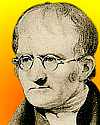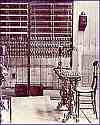
On 6 Sep 1811, James Melville Gilliss was born, the U.S. naval officer and astronomer who founded the Naval Observatory in Washington, D.C., the first U.S. observatory devoted entirely to research. When he started out, he taught himself astronomy, at a time when there was no fixed astronomical observatory in the U.S., and very little formal instruction. In 1838, he became officer-in-charge of the Depot of Charts and Instruments, forerunner of the U. S. Naval Observatory. Accurate star charts were essential for the navigation of ships, since they provided for the measurement of an observer's position. Upon his death, a Biographical Memoir of James Melville Gilliss was presented before the National Academy (1866). As you read it, you can reflect on the extensive, dedicated work required building up the body of knowledge for effective navigation at sea, long before GPS location finding was as available from the nearest cell phone. The name of Gilliss now goes mostly without recognition, but his work was of great significance in his era.

On 6 Sep 1908, Louis Essen was born, the English physicist who invented the first practical atomic clock, a device capable of measuring time more accurately than any previous clock. Now, precision time has become imbedded in modern activities. Today's book pick is: , by who picks up the history of time-keeping with astronomical methods, and ends with the GPS satellites which give nanosecond accuracy. With such a small time increment, compensation is required for the effects of special and general relativity. The largest part of the book deals with the development of time-keeping, and includes the story of the revolution brought about with atomic clocks, how they work, how more than 200 of them are used to form the world's time, and why we need leap seconds. No longer is time a function of the motion of the earth around the sun; physicists now define the second in terms of the fundamental properties of atoms.
It is available from Amazon, typically about (As of earlier time of writing - subject to change.)
 | Chemical analysis and synthesis go no farther than to the separation of particles one from another, and to their reunion. No new creation or destruction of matter is within the reach of chemical agency. We might as well attempt to introduce a new planet into the solar system, or to annihilate one already in existence, as to create or destroy a particle of hydrogen. |
 | The history of science has proved that fundamental research is the lifeblood of individual progress and that the ideas that lead to spectacular advances spring from it. |
 | I might paraphrase Churchill and say: never have I received so much for so little. [Exemplifying humility, upon accepting the Nobel Prize in Chemistry.] |
| Before you look at today's web page, see if you can answer some of these questions about the events that happened on this day. Some of the names are very familiar. Others will likely stump you. Tickle your curiosity with these questions, then check your answers on today's web page. | |
| Births | |
 | Louis Essen, born 6 Sep 1908, invented the first practical atomic clock. He built a atomic-beam clock utilizing the natural frequencies of an atom that are inherently stable over time and space to greatly increase the accuracy of time-keeping. The atoms of which element were used in Essen's atomic clock? |
 | On 6 Sep 1766, John Dalton, a giant in the history of chemistry was born - an English scientist, known as one of the fathers of modern physical science. What was his notable contribution to chemistry? |
| Deaths | |
 | Sir Frederick Abel (1827-1902) was an English chemist and military explosives specialist who co-invented cordite (1889) to replace gunpowder in weapons What was the advantage of cordite over gunpowder? |
 | On 6 Sep 1970, Arthur Herrington died, an American engineer and manufacturer who developed a series of military vehicles. His best known served various functions in World War II, including as a litterbearer, machine gun firing mount, reconnaissance vehicle, pickup truck, front line limousine, ammo bearer, wire-layer and taxi. What was this vehicle? |
| Events | |
 | On 6 Sep of a certain year, the first British telephone exchange opened in Lombard Street, London. What was the decade of this event? |
 | On 6 Sep 1947, the aircraft-carrier Midway became the first U.S. vessel from which a long-range rocket was launched. It was fired from the flight deck from a position at sea several hundred miles of the east coast of the U.S. the rocket travelled about 6 miles. However, the rocket being observed was not American-made. Why was the rocket used for the first U.S. vessel launch not American-made? |
Fast answers for the previous newsletter for September 5: canal rays • Euclid • suicide • anthropology • decade of 1887 • estimated seven miles.
 If you enjoy this newsletter, the website, or wish to offer encouragement or ideas, please send feedback by using your mail reader Reply button.
If you enjoy this newsletter, the website, or wish to offer encouragement or ideas, please send feedback by using your mail reader Reply button. Your click on a Facebook, StumbleUpon, or other social button on the site webpages is also a welcome sign of appreciation. Thank you for using them.
© This newsletter is copyright 2020 by todayinsci.com. Please respect the Webmaster's wishes and do not put copies online of the Newsletter — or any Today in Science History webpage. (If you already have done so, please remove them. Thank you.) Offline use in education is encouraged such as a printout on a bulletin board, or projected for classroom viewing. Online, descriptive links to our pages are welcomed, as these will provide a reader with the most recent revisions, additions and/or corrections of a webpage. For any other copyright questions, please contact the Webmaster by using your mail reader Reply button.
--
If you do not want to receive any more newsletters, Unsubscribe
To update your preferences and to unsubscribe visit this link
Executive Real Estate Business Class
-
"It was like a man with wings. It wasn't like anything you'd see on TV or in a monster movie." ...
About the publisher
Search This Blog
Blog Archive
-
▼
2021
(585)
-
▼
September
(95)
- 800-Year-Old Tomb Discovered in Peru
- 600-Year-Old Muisca Jars Recovered in Colombia
- Human Footprints in North America Dated to 23,000 ...
- September Quiz
- Gas pipe workers find 800-year-old burial bundles
- Gas pipe workers find 800-year-old burial bundles
- Dark Destiny!
- Long-Distance Trade Detected in Genomes of Siberia...
- Composition of Stone Tools From Roman Morocco Anal...
- New Thoughts on Maya Pyramid in El Salvador
- This Civil War–Era Eagle Sculpture Was Made Out of...
- Roman gold coins found off coast of Spain
- Roman gold coins found off coast of Spain
- Review of The Bombay Prince by Sujata Massey, a my...
- DNA Analysis Identifies Japanese Ancestors
- Ritual Objects Discovered in Northern Egypt
- 'Band of Brothers' Stars Reflect on the Epic Minis...
- ‘Cake mummy’ survived WWII bombing of Lübeck
- ‘Cake mummy’ survived WWII bombing of Lübeck
- Am I my heroines?
- Medieval Mass Graves Excavated in Lebanon
- Three Phases of Wooden Wagon Way Uncovered in Scot...
- Rare Shell Artifacts Discovered in South Australia
- Burned Layer at Jamestown Linked to Bacon’s Rebellion
- Burned Layer at Jamestown Linked to Bacon’s Rebellion
- Painted 14th c. burial vaults found in Bruges
- Painted 14th c. burial vaults found in Bruges
- Possible Grave of Medieval Christian Hermit Excava...
- My notebook and I got drenched and my story was bo...
- Woman buried with heavy bronze jewelry found in in...
- Woman buried with heavy bronze jewelry found in in...
- Birthdays in History
- Teaching "All Men are Created Equal" (Part II)
- Psychologically Speaking, Who Were the Heads of th...
- Christmas Roses
- For Constitution Day, Let's Toast the Losers of th...
- We are All Becoming Cassandras: Leaders Must Heed ...
- Inequality Tends to Reach Political Tipping Points...
- The Roundup Top Ten for September 17, 2021
- Memo From Irish History: Welcome to Your Future, A...
- Rediscovered early drawing by Van Gogh on display
- Rediscovered early drawing by Van Gogh on display
- Hispano-Visigothic grave found at Spain cave hermi...
- Hispano-Visigothic grave found at Spain cave hermi...
- Searching for the Fisher Kings
- Bone Tools in Morocco May Be Earliest Evidence of ...
- Did Eurasia’s Early Bronze Age Pastoralists Drink ...
- The Trousseau
- Wood lion head recovered from Finnish shipwreck
- Wood lion head recovered from Finnish shipwreck
- The Floating Book by Michelle Lovric, a sensual no...
- Sculpture of Lord Ganesha Uncovered in Southeaster...
- Saudi Arabia’s Rock-Cut Camels Redated
- Possible Parietal Art Discovered on the Tibetan Pl...
- Renaissance shield looted by Nazis returned to Cze...
- Renaissance shield looted by Nazis returned to Cze...
- Anglo-Saxon Silver Brooch Recovered in England
- Roman Sewer System Discovered in Turkey
- Face of “Dutch Neanderthal” Reconstructed
- Gupta-Period Temple Found in Northern India
- The Polynesian 'Prince' Who Took 18th-Century Engl...
- When George Washington Took a Road Trip to Unify t...
- On 9/11, a Flotilla of Ferries, Yachts and Tugboat...
- Southern Tomb in Djoser funerary complex opened
- Southern Tomb in Djoser funerary complex opened
- Ask A Wench — What We've Been Watching
- Possible Prehistoric Campsite Uncovered in Norther...
- Statue of Roman Emperor Hadrian Unearthed in Turkey
- When George Washington Took a Road Trip to Unify t...
- Byzantine-era axe, machete found in ancient city
- Byzantine-era axe, machete found in ancient city
- Early Hollywood is a family affair in The Limits o...
- Maya rulers installed in Met’s Great Hall
- An Interview with Susanna Kearsley
- ENTER THE HEART OF DARKNESS | Legend of the Supers...
- ENTER THE HEART OF DARKNESS | Legend of the Supers...
- The Disturbing Case of Xavier Dupont de Ligonnès
- Newsletter for Sunday 12 September.
- Newsletter for Saturday 11 September.
- ‘Rise and Fall: The World Trade Center’ Premieres ...
- Newsletter for Friday 10 September.
- Newsletter for Thursday 9 September.
- Newsletter for Wednesday 8 September.
- Holiday savings - extended!
- Support Black-Owned Businesses: 181 Places to Star...
- Newsletter for Tuesday 7 September.
- Holiday savings for the whole family!
- Newsletter for Monday 6 September.
- Three All-New 9/11 Documentaries
- Newsletter for Sunday 5 September.
- Newsletter for Saturday 4 September.
- Labor Day Sale at the History Store
- Newsletter for Friday 3 September.
- Newsletter for Thursday 2 September.
- Newsletter for Wednesday 1 September.
-
▼
September
(95)
-
Blogroll
-
About
HistoryFact










0 comments:
Post a Comment